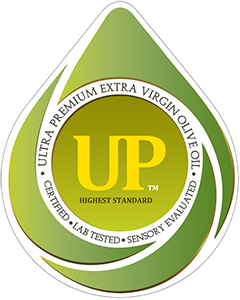 Ultra Premium (UP) is a new category of olive oil that distinguishes the highest quality olive oil in the world. The UP standard was created in response to the growing need to separate high quality extra virgin olive oils from what dominates the so called “gourmet” and “premium” olive oil markets, as well as the broader category sold in mass markets the world over under thousands of brands and private labels. The absurdly low standards created and fostered by numerous trade associations and government agencies responsible for policing them has only contributed to the confusion and misinformation. EU producers are actually given a perverse incentive in the form of government subsidies to keep their oils in storage until market conditions improve. This practice clearly demonstrates the governmental complicity with retailers and bottlers to sacrifice quality for price. Lack of enforcement and testing by these trade associations and governmental agencies has led to a marketplace dominated by inferior oils and rife with adulteration. These practices by some of the world’s largest olive oil producers and bottlers have led to a steep decline in prices of extra virgin olive oil and are driving quality oil producers out of business.
Ultra Premium (UP) is a new category of olive oil that distinguishes the highest quality olive oil in the world. The UP standard was created in response to the growing need to separate high quality extra virgin olive oils from what dominates the so called “gourmet” and “premium” olive oil markets, as well as the broader category sold in mass markets the world over under thousands of brands and private labels. The absurdly low standards created and fostered by numerous trade associations and government agencies responsible for policing them has only contributed to the confusion and misinformation. EU producers are actually given a perverse incentive in the form of government subsidies to keep their oils in storage until market conditions improve. This practice clearly demonstrates the governmental complicity with retailers and bottlers to sacrifice quality for price. Lack of enforcement and testing by these trade associations and governmental agencies has led to a marketplace dominated by inferior oils and rife with adulteration. These practices by some of the world’s largest olive oil producers and bottlers have led to a steep decline in prices of extra virgin olive oil and are driving quality oil producers out of business.
The self serving overemphasis on “Where” extra virgin olive oil is produced continues to dominate perceptions at the expense of the far more significant “When, What, and How” the oil is made. The UP standard has as its principal barometers Chemistry and Freshness. These two underappreciated variables can be objectively measured, quantified, and certified. Since the highest quality EVOO comes from high quality fruit coupled with high quality production processes, the UP standard encompasses strict requirements for both the end-product and the production process.
No matter how high the quality of fruit and production methods used, the best olive oils in the world are never as good as when they are fresh. There are no standards for shelf-life of EVOO, and the current IOC “best buy” date is intentionally misleading and utilized at the whim of the retailer and bottler. When a quality EVOO is fresh, there is significantly more positive sensory attributes detectable by the palate. As any EVOO ages, it naturally oxidizes losing positive sensory qualities as well as inheriting defects. Newly developed tests can objectively quantify the “Freshness” of an EVOO at various stages in its lifecycle and are referred to as the “Fresh Pack” tests encompassing both the Diacylglycerol Content (DAGS) and Pyropheophytins (PPP).
The UP standard is reserved for the finest extra virgin olive oils in the world. As such, the UP grade exceeds all existing European, Italian, Spanish, Greek, North American, Californian, or any other standard for the grade known as extra virgin olive oil. In order to qualify for the UP grade, the extra virgin olive oil must meet or exceed a comprehensive set of Production, Storage, Transportation, Testing, Chemistry, and Organoleptic requirements as set forth in the following document. Instead of placing an overemphasis on what is less important (Terroir) to the detriment of the most critical factors (Chemistry and Freshness), the UP program is intended to reward farmers for producing high quality oil. The UP program is intended to promote Fair Trade practices and help create a demand for a higher quality product thereby increasing the value.
Objective, verifiable chemical standards form the foundation of the UP grade. Chemical analysis of EVOO has proven to be a fundamental indicator of sensory quality, predictor of perishability, and authenticity of olive oils. UP is the highest quality standard in the world because it utilizes the broadest array of available tests and enforces the strictest limits on all chemical standards.
Chemical Parameters |
Determination |
Indicators |
Extra Virgin Standard |
UP Standard |
| Free Fatty Acids (FFA) | Free Fatty Acids are formed due to breakdown of the triacylglycerols in oils during extraction. Fatty acids are “free” when the are no longer bound to any other molecules. | An elevated level of FFA can indicate poor quality or mishandled fruit, too much time between harvesting and extraction, poor storage and/or high temperature during extraction. | Units: % as oleic acid IOC limit ≤ 0.8 |
Units: % as oleic acid UP limit ≤ 0.3 |
| Oleic Acid | The major fatty acid in olive oil triacylglycerols is Oleic acid making up 55 to 85% of olive oil | The higher the oleic acid monounsaturated fat content translates to increased durability and shelf-life. | Units: % as oleic acid IOC limit ≥55 |
Units: % as oleic acid UP limit ≥ 65 |
| Peroxide Value | Peroxides are primary oxidation products that are formed when oils are exposed to oxygen causing defective flavors and odors | Primary measurement of rancidity in oil. Higher peroxide levels indicate oxidized and/or poor quality oil & give an idea of the freshness & storage conditions. | Units: mEQ O2/kg oil IOC limit≤20 |
Units: mEQ O2/kg oil UP limit ≤9 |
| UV Absorption | UV spectrophotometric determination Secondary measurement of rancidity in oil. Elevated levels of UV absorption indicate oxidized and/or poor quality oil, possible refining and/or adulteration with refined oil. | Secondary measurement of rancidity in oil. Elevated levels of UV absorption indicate oxidized and/or poor quality oil, possible refining and/or adulteration with refined oil. | Units: K1%/1cm IOC limits K232 ≤2.5, K270≤0.22, DeltaK≤0.01 |
Units: K1%/1cm UP limits K232 ≤2.0 K270 ≤0.20, DeltaK ≤0.01 (immediately after production) |
| Phenolic Content (Polyphenols) | Phenols are healthful anti-oxidant substances in olive oil which aid in slowing down the natural oxidative processes. | Phenolic content decreases over time and is an indicator of freshness, with higher amounts improving shelf-life and oxidative stability. | N/A | Units: (as ppm caffeic acid) UP minimum limit ≥ 130 |
| DAGs | Fresh olive oil has a much higher proportion of 1,2-diacylglycerols to Total diacylglycerols while olive oil extracted from poor quality fruits and refined oils have a higher level of 1,3-diacylglycerols | The ratio of 1,2-diacylglycerols to the Total diacylglycerols are a useful indicator of fruit quality and acts as a snapshot of olive oil freshness. Low values can also indicate oxidized oil & sensory defects. | Units: %Total 1,2-diacylglycerols AOA limit≥35 |
Units: %Total 1,2-diacylglycerols UP limit ≥*90 (immediately after production) |
| PPP | Upon thermal degradation of olive oil, chlorophyll pigments break down to pheophytins and then to pyropheophytins | The ratio of pyropheophytins to the total pheophytins is useful for distinguishing fresh olive oil from soft column refined, deodorized, or backblended oils. | Units: %Total Pheophytins AOA limit≤17 |
Units: %Total Pheophytins UP limit ≤5 (immediately after production) |

